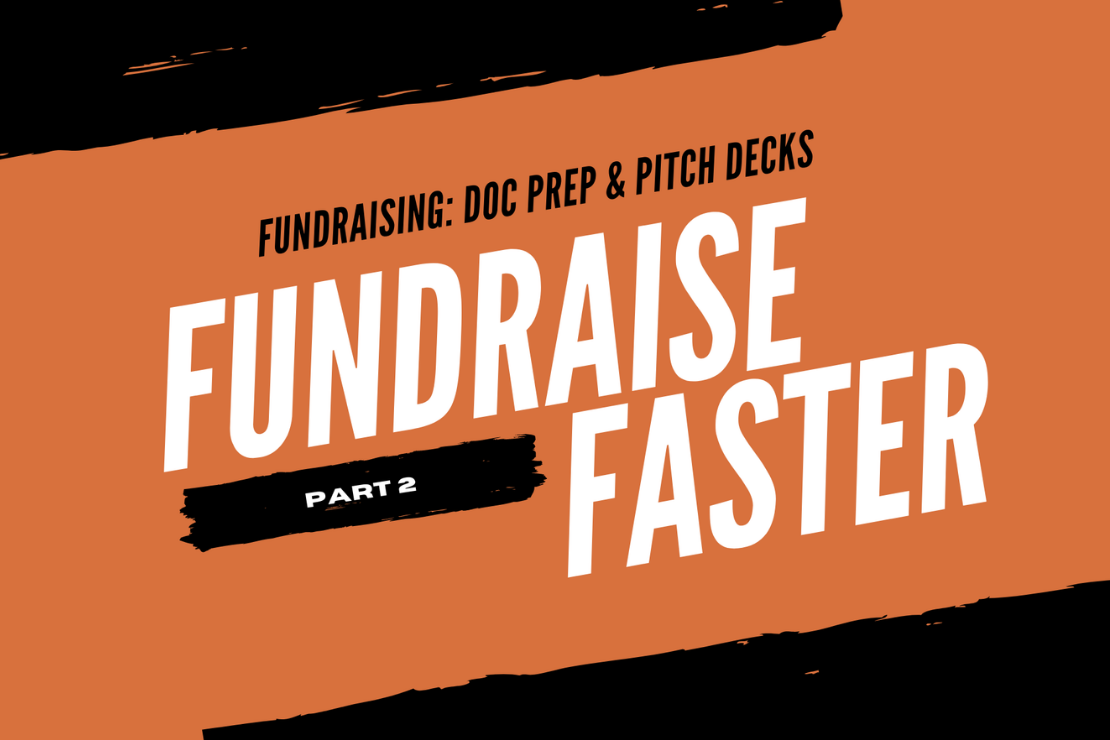Fundraise Faster, Part 2: Doc Prep and Pitch Decks
Mar 10, 2021

In Part Two of Fundraise Faster, Brett Brohl, MD of Techstars Farm to Fork Accelerator, talks through a few of the most important docs you need to have ready prior to starting a fundraise, including your pitch docs, your financials, and your diligence collateral.
Fundraise Faster is a three-part series. Read and watch Part One and Part Three.
Prep time.
In Part I of Fundraise Faster we talked about the why, when and how much of fundraising venture capital. In Part 2, we’re going to chat about documents — specifically what sort of documents (or collateral) you should have ready to go before you start your fundraise.
In the video of Part 2, I talk through a few of the most important docs you need to have ready prior to starting a fundraise. Specifically your Pitch docs, Financials and your Diligence collateral. The most common questions from founders revolve around pitch decks and executive summaries.
We’ve talked about executive summary best practices in the past so today I’m going to focus primarily on your pitch deck. There are 11 specific items founders should cover in a deck.
Before diving into individual slides let’s talk about the order of your deck. The rule of thumb is there’s no definitive rule! — there’s no right or wrong order. The only major guideline for an order that everyone should remember is that you need to hook people early on, and that means, put something that is incredibly compelling upfront; that could be your team, traction, tech, the immense problem you’re solving or something else.
I am a firm believer that founders need to demonstrate their big vision. Even if it is a few steps away from where they currently operate today. That being said, It’s important to walk a fine line between vision and focus. In practice this usually means that the early parts of your deck are “here’s a really cool thing that we have, we’re really hyper-focused on this and here is our traction” but in the future “here’s how we’re gonna take over the world.”
We’ve put together a super sparse slide deck with a few prompts for each of my recommended slides that you can make a copy of and download here. This is just an outline but remember, as I say in the video, design matters! I say this as someone who is terrible at design. That’s why I’ve found tools and people to help (like beautiful.ai where we mocked up this deck).
A few notes and thoughts on each slide I like to see in a pitch deck:
Problem
As best you can, focus on what’s the pain point that you’re solving, what’s the real acute pain point that nobody else is solving well today?
Most common mistake is putting a very wide, general industry analysis statement instead of clearly (and narrowly) identifying the pain that the customer feels.
Anytime you can use metrics or stats to illustrate the problem you’re solving, do it!t
Team
I personally don’t love advisory slides unless they’re super involved;
Highlighting something cool that you’ve built or why are you building this company?
Founder-market fit — why are you uniquely positioned for this market? What is the personal connection?
Get creative, let your personality come through.
Solution/Demo
Show don’t tell as much as you can.
If there’s opportunities to link to a video, do it.
What does the thing actually look like?
Traction/Milestones
Avoid vanity metrics!
KPI’s — Use them & Show historical progress.
Can you run a cohort analysis? If so, do it!
Projections
Don’t send detailed financial projections (a screenshot of your excel spreadsheet in your deck is an eyesore and unnecessary!);
Be broad; 5 year annualized revenue projections; if you have actuals include those
Make sure your projections in the deck match your detailed financial projections that will be sent separately!
Up and to the right! But be able to back your numbers up with smart assumptions.
Business Model
How do you actually make money? (i.e. what is your revenue model?)
SaaS, RaaS, DaaS, Selling a physical product, consulting?
Market Opportunity
How big is the market? What’s your TAM? (And SAM and SOM if it is additive!
TAM can be very broad but it is specific to your product and the future vision of your company. TAM is NOT “$3 trillion is spent of food each year….”
Don’t play the “If we just get 1 %…” game.
Differentiation
A graph with an XY access and your logo in a quadrant that no one else is in isn’t very compelling.
What specifically makes you different?
What specifically is your moat?
Marketing/Sales Plan
What’s your go-to-market strategy, high-level?
Is there a secret sauce that will allow you to grow exponentially? Network effect? Land and expand? Direct sales?
What is special about your plan?
The Ask
How much are you raising? What’s the round size
Use a dollar figure not nomenclature, “Series A” means different things to different people.
Do NOT pitch your valuation until you have a term sheet! It’s very rarely helpful, and in fact, it can often be destructive
Vision
If you are raising traditional venture you need to have a HUGE vision for the company.
How are you going to take over the world?
A reminder that you can grab our simple deck outline via Google Slide by clicking here and copying the deck to a new file. From a design perspective one of my favorite resources (and how we made this outline) is Beautiful.ai — my team and I use it to make our presentations really clean and professional looking. As you get deeper into your startup's lifecycle and have a bit more budget to spend on doing custom deck design, check out Sketchdeck. We’ve enjoyed working with them and they’ve turned out awesome custom design.
That’s it for Part 2 — next up in Part 3 we’ll go even deeper into setting up your fundraising process and talk about creating and using a target list of investors.
This article originally appeared on Medium.
About the Author

Brett Brohl
In addition to being the Managing Director of the Techstars Farm to Fork Accelerator, Brett Brohl is the Founder of Bread and Butter Ventures, an early stage venture capital fund. He is an experienced entrepreneur, investor, and mentor. He honed his startup skills as the CEO of multiple companies, leading three to exit. Brett publishes his tips and best practices for founders and investors on his YouTube channel, Brett’s Brain.
